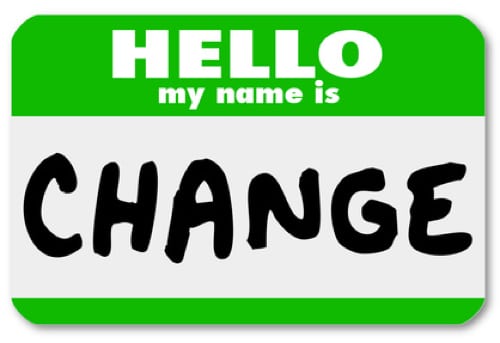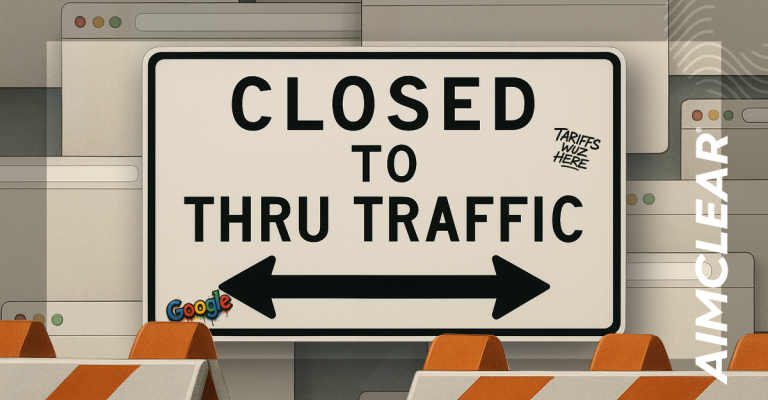Welcome back to AIMCLEAR‘s continuing coverage of #SESSF 2013! Let’s dive in and kick-off the official reporting with a recap of day one’s keynote address. Presented by Jeffrey Hayzlett, (@jeffreyhayzlett) best-selling author, business change agent and marketing expert, the keynote titled, Running the Gauntlet: Driving Strategic Change in Your Business, was a hearty serving of business (and life!) inspiration. Let’s talk about why!
Hayzlett’s keynote focused on the idea of change – why it’s a good thing for business, and how folks can go about being agents of change in their companies. To kick things off, Hayzlett issued a couple warnings to emphasize the importance of strategic change:
“If we don’t adapt, change or die…we do die.”
AND…
“To the naysayers, opportunists, and obstructionists who stand in the way of driving change and progress in any organization, note: WE WILL BEAT YOU.”
Well, if that’s not motivational…
He went on to describe that while change is extremely important for moving businesses forward, it’s typically difficult to accomplish. But to clarify, change for the sake of change is never a good idea. To emphasize, Hayzlett shared a quote from Winston Churchill, “There is nothing wrong with change, if it is in the right direction.” Good point.
Successful business people are agents of change, or what Hayzeltt calls, “clock changers.” What does that mean, you ask? Hayzlett explained with a story. When he first started as the chief marketing officer of Eastman Kodak, he entered one of his first meetings early and changed the clock on the wall so it was 30 minutes fast. As his colleagues entered the room, he watched as they looked at the clock, then at their watches, and back at the clock. And soon, arguments began to arise as to why the clock was wrong, who was responsible for the problem and who should fix it. Meeting after meeting went by, and Hayzlett watched as people continued to argue over why the clock was still wrong. And then one day, a woman pulled a chair up to the clock, changed it by hand and fixed the problem. The next day, Hayzlett named her the chief of staff.
The lesson? While it’s important to bring up problems in a company, it’s even more important to bring forward solutions. Good leaders are clock changers, people!
Next, Hayzlett got into the meat of his keynote and discussed the five ways people and companies can be clock changers and ultimately drive strategic change.
1. Fear (Be a beginner)
People are afraid of failing, everyone knows that. But, while failing is scary, leaders can’t let fear get in the way of driving change. For example, Hayzlett always wanted to be a cowboy, own a ranch and ride horses. A few years back, with no knowledge of how to be cowboy, he bought himself some horses. After much research and preparation, he decided it was time to ride one. One day, Hayzlett went to the stable, took the bridle to the horse, and struggled (and struggled some more) to put it on. After many failed attempts, he found a 14-year-old girl riding at the stable, and had her teach him how to put on.
The lesson? In order to drive strategic change, you have to be a beginner. Or in Hayzlett’s words:
“If you want to be a maestro, you have to play a lot of bad notes.”
2. Tension (Healthy debate is good)
Most people, especially in business, try to avoid problems, but avoiding tension is essentially avoiding problem solving. In fact, the job of human resources and legal advisors is basically to avoid tension at all costs! But in order to progress, clock changers need to question everything and cause tension! Hayzlett reminded the audience that especially in the world of search where everything is new and constantly progressing, causing tension should be the search marketer’s charter.
The lesson? No pain, no gain – cause tension and watch strategic change unfold.
3. Radical Transparency (Elephants are fun to kill)
In order to drive strategic change, every person and corporation should operate with radical transparency. What does this mean? Clock changers are people who talk about the things they don’t want to talk about, they bring up those pink elephants all. the. time. Essentially, change can’t happen when people ignore problems and don’t ask for help. And when change can’t happen, the whole team, or the whole business suffers.
The lesson? Ask for help, bring up problems and kill that pink elephant!
4. Take Risks (No one is going to die)
In marketing, it’s important to take risks and remember that even if you fail, no one is going to die. An example: While at Kodak, Hayzlett helped drive the company into the ink jet business, a very profitable industry (side note, did you know ink is more expensive by volume than oil, water, vodka and champagne?). To help announce Kodak’s new ink jet offerings, Hayzlett pioneered an advertisement that would show during movie previews and then ask viewers to text a number in order to receive a discount coupon for ink (which was quite the risk at the time, as mobile advertising was quite new). While the ad received a double-digit response (!) in testing, it completely bombed in real life. In a meeting to discuss the disappointing results, Hayzlett asked his team to explain why the ad was such a failure. One colleague piped up that maybe the ad failed because when people enter movie theaters the first thing they do is turn off their phones….oh right, duh.
While this instance highlighted the importance of practicing transparency (and raising questions, even when they challenge the CMO’s ideas), it was also an example of why taking risks is important. While this particular ad failed, Hayzlett and his team went on to repurpose the campaign and ultimately launch a successful ink jet business – all because they took a risk and learned from their mistakes.
The lesson? You’re going to fail, you’re going to embarrass your company, but no one will die, and ultimately you’ll become better and stronger for it.
5. Promises (Mutual Conditions of Satisfaction)
A promise in business and in life, consists of mutual conditions of satisfaction: I will give you X and in return, you will give me Y. This typically occurs in what Hayzlett calls an Action Cycle that occurs between a customer and a performer. Phase one of the cycle is an offer, phase two is an agreement, phase three is doing the work and phase four is delivering.
In business, one of the most important promises you can make is through your brand. As Hayzlett put it, “a brand is a promised delivered.” Something to consider then, is what promise are you trying to deliver? If you can clearly answer this question, you’ll better be able to not only create a respected brand, but deliver on its promises.
Want to dive even deeper into the Hayzlett world of change? Check out his book, Running The Gauntlet.
Big thanks to Jeffrey Hayzlett for starting off #SESSF on such a positive (and very hilarious note). Stay tuned for more AIMCLEAR coverage, there are lots of great sessions ahead and we’re just getting started!











